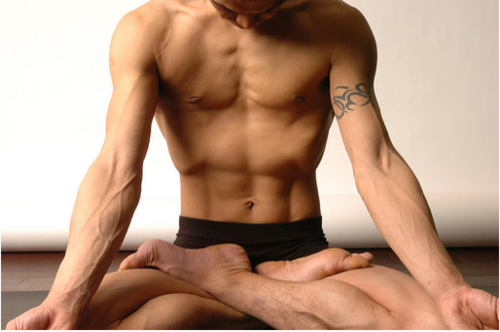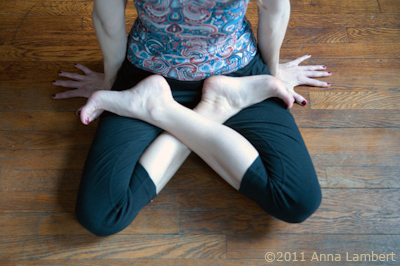how to work toward padmasana: lotus pose

So you want to do padmasana. Because like headstand, lotus pose is an asana that comes to mind when people think of yoga. And for good reason. It’s one of the fifteen poses mentioned in the 15th century text, the Hatha Yoga Pradipika, which makes it one of the few asanas with a history. There is no shortage of stock photos of blissed out ladies sitting in lotus whilst meditating on the beach. And you want that. I must warn that while I’m something of a beachcomber, I have never once come across such a lady in a natural habitat. Or gentleman. Perhaps with a little work we can change that.
But my knees!
 While padmasana can injure the knees and ankles, the knees aren’t the problem, unless you’ve already forced yourself into the position and hurt them. It’s the hips. Lotus requires a dramatic external rotation of the hip joints, and this is easier for some bodies than others. Some hip joints are happier in external rotation, and others internal rotation (e.g. virasana). It’s rare that a body is equally happy in both.
While padmasana can injure the knees and ankles, the knees aren’t the problem, unless you’ve already forced yourself into the position and hurt them. It’s the hips. Lotus requires a dramatic external rotation of the hip joints, and this is easier for some bodies than others. Some hip joints are happier in external rotation, and others internal rotation (e.g. virasana). It’s rare that a body is equally happy in both.
My hips seem externally rotated at the joint themselves, to the point that my internal rotation is laughable. I have to accept that and work with it. Triang mukhaikapada paschimottanasana is easily my worst pose in primary series, and it’s easy for me to forget that while it’s still bad, it wasn’t that long ago I couldn’t bind without falling on my side. I had to ground my elbows on the floor by my extended leg to keep upright. With practice, I eventually learned to stay upright and bind. I say this because there are limitations and there are gifts. External hip rotation is easy for me. I have no memory of ever not being able to do lotus easily. If that is not the case for you, go slowly and be patient with yourself, as I must in internal hip rotations. If you practice daily, you don’t even notice the progress. But it eventually happens.
How to Get the Hip Flexibility Needed for Padmasana
Most of the Padmasana how to’s out there (e.g. image below left) are helpful only if you need some help going into the pose, but can pretty much do it. If you can’t do it, they are only frustrating. What you need help with is opening the hips. Folding your legs properly just isn’t the issue. Yet.
Joints aside, the biggest culprit in difficult external hip rotation are tight piriformis muscles. This happens when you sit at a desk all day. Your gluts get lazy and your hip flexors fierce (also why you hate Utthan Pristhasana, aka lizard, but we’ll talk about that another day).
The very best way to get yourself into padmasana shape? It’s the answer I give to 97% of questions. Practice frequently. Like headstand, you don’t have to do specific poses day after day to prepare yourself for lotus. A well-rounded class will open your hips. I include poses like Virabhadrasana II (Warrior II), Parsvakonasana (Side Angle), Trikonasana (Triangle), Janu Sirsasana (Head-to-Knee Forward Bend), Ardha Matsyandrasana (Seated Twist), and Eka Pada Rajakapotasana (pigeon) in every class so that your hips are regularly coaxed into flexibility.
Equally important, if padmasana is a goal: Sit in ardha padmasana (half lotus) at your desk as often as you can. This will not only support your spine better than sitting with your feet on the floor, it will prepare you for full lotus. I’m writing this from a friend’s place, sitting in a fancy chair. But I’m much more comfortable at home, where I sit at my desk cross-legged on a flat, wooden kitchen chair with a pillow for lumbar support. This ergo-dynamic contraption I’m on now is all contoured out of proportion to a lotus seat, and the arms get in the way of my feet. I’m pretty much just squashed in, as I find it impossible to sit upright with my feet on the floor. I slouch. So get your feet up and cross your legs. When that’s tolerable for an hour or so at a time, move into half lotus (with one foot up on the hip instead of two) for as long as possible. Sitting like this daily will bring you to full padmasana much faster than just practicing in class.
Benefits of Padmasana
 Once you’re comfortable (and that could take years), lotus is incredibly supportive of the spine and your posture, because the pelvis sits very upright. It stretches the hips, knees and ankles. It’s also said to calm the brain and nervous system, stimulate abdominal organs, soothe menstrual cramps and sciatica, and if done during pregnancy, ease childbirth. According to the Hatha Yoga Pradipika, it also destroys all disease and awakens kundalini. And like the gentleman in the photo, you will become hairless. Maybe.
Once you’re comfortable (and that could take years), lotus is incredibly supportive of the spine and your posture, because the pelvis sits very upright. It stretches the hips, knees and ankles. It’s also said to calm the brain and nervous system, stimulate abdominal organs, soothe menstrual cramps and sciatica, and if done during pregnancy, ease childbirth. According to the Hatha Yoga Pradipika, it also destroys all disease and awakens kundalini. And like the gentleman in the photo, you will become hairless. Maybe.
Personal Note
When I started doing lotus daily, my shins felt as if they were grinding into one another. It was painful. Why I cannot explain, but with daily practice, it just went away. Because I practice ashtanga, I always draw the right leg up first. If I draw up the left side first, I have the grinding pain. I imagine I’d have to do left side first every day to even this out. Perhaps it’s some remaining tightness in the hips that causes the sharp bones to press to firmly together, which eventually eases. Regardless, know that it will go away with regular practice.
I have improved at my ability to sit in padmasana, but after years of working at it, I am convinced there’s a skeletal issue at play. More efforts to push into external rotation on my right hip usually brings sacroiliac pain. I have found, as with all yoga of the physical realm that there’s a modification that allows a comfortable, steady seat. Then the bandhas and the practiced concentration provide what’s lacking in the bind of the legs. Thanks for the considered analysis!
Hi Peter,
Thanks for the comment. Yes, a skeletal issue would correspond with the internal/external rotation theory. I agree that pushing is not wise and that full lotus isn’t necessary for everyone.
That said, when I gave my teacher the skeletal argument for triang mukhaikapada paschimottanasana, he said, “Yes, but your hip is less flexible on the left than the right, so there’s more to it than that,” which is true (for me in that pose). I’ve been fairly amazed by what daily concentrated practice and the gentle nudging of my teachers has done for my own ideas about my limitations. I can do poses I never thought I could do or even wanted to do, because of daily practice and good guidance.
I’m not at all saying this about your lotus, but because less experienced practitioners might makes excuses and limit themselves unnecessarily. I do it all the time!
Hello,
When ever I sit in the lotus pose I always do my left leg first then my right leg but I would like to know why my right leg slips and slides and falls down every time I put my right leg second
Hi Matthew,
Hmmm. Assuming there’s no pain at all in your joints, are you flexing your feet and engaging your leg muscles inward toward your center to avoid the slip? Padmasana is somewhat active in the legs and root lock. If you are not engaged there could be slipping. If you still slip, just keep trying gently a few times a day. If you are patient, it will come!
Anatasia, Yeah I am flexible enough but the thing is how do you engage your leg muscles inward? I try to put my leg up on my thigh as high as possible to try to avoid the slip but it does not work Also, how do I flex my feet? Thank you for the response
Hi. You flex your feet before going into the pose, and keep them that way. You engage by contracting your leg muscles, so that the legs hug in toward you. This, however, is not the best way to learn! Do you have a teacher?? Best, Anastasia
Sadly I do not have a teacher but I do practice this pose frequently and two more questions first what is a way to flex my feet? and another question is how do I contract my leg muscles? Thank you and have a nice day
Matthew, get thyself to a teacher. Immediately!!